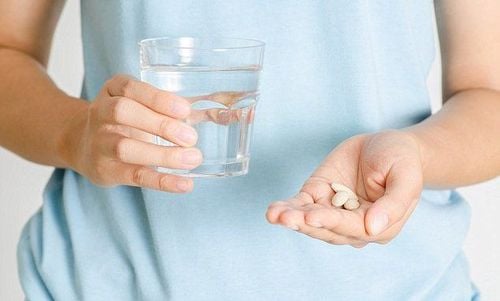Vitamin D3 is often used to treat or prevent conditions caused by vitamin D deficiency, especially skin or bone conditions. This vitamin is better than other types of vitamin D and increases blood vitamin D levels more than vitamin D2. Vitamin D3 will be effective when used in the right dose and at the right time. Therefore, how to use vitamin D3 effectively while still ensuring safety for the body is something that many people are interested in today.
1. What is the effect of Vitamin D3?
Vitamin D3 Also known as cholecalciferol, it is a fat-soluble vitamin that is processed by the liver and kidneys. Once in the body, it binds to a number of cells in the body to help regulate calcium and phosphorus from food. Vitamin D3 has many health benefits, such as:
1.1 Bones
Vitamin D can enhance calcium absorption in the small intestine, supporting bone density and muscle growth. If the body does not have enough vitamin D to absorb calcium, the body will take calcium from the bones. This makes the bones weak, brittle and increases the risk of osteoporosis.
Studies show that adequate vitamin D supplementation can reduce the risk of fracture and improve muscle strength. Additionally, supplementing with high levels of vitamin D3 in the diet can help the body achieve peak bone mass in adulthood and prevent osteoporosis.
1.2. Immune system
Several studies have shown that adequate vitamin D3 supplementation may protect against acute respiratory infections and pneumonia.
1.3. Cardiovascular
Studies show that obese people and high blood pressure often have low levels of vitamin D3. Therefore, some conclude that adequate vitamin D3 supplementation can reduce blood pressure, reduce the risk of stroke and heart attack.
1.4. Weight loss
In some studies in postmenopausal women, adequate vitamin D3 supplementation was associated with lower waist circumference and BMI index in balance
Although vitamin D has many health benefits, the body cannot synthesize this vitamin on its own. Vitamin D3 is produced by the body when the skin is exposed to sunlight. Sunscreen, protective clothing, limited exposure to sunlight, dark skin and age can prevent the body from getting enough vitamin D from sunlight. Another source of vitamin D3 is from food, the foods people eat every day. Therefore, you need to know how to properly and effectively supplement this vitamin source for the body. This is essential to ensure normal body functions. When natural sources are not enough, using vitamin D3 in the form of pharmaceuticals and functional foods is necessary.
2. How to supplement vitamin D3 for the body
If you need to supplement vitamin D for your body, you can use vitamin pills, expose yourself to sunlight or increase your intake. Foods containing vitamin D.
2.1. Vitamin D3 supplements
Supplementing vitamin D through food is one of the safest and simplest ways. Specifically, foods containing vitamin D3 include:
- Animal sources: Beef liver; Butter; Cereals; Cheese; Cod liver oil; Egg yolks; Fresh salmon; Large halibut; Mackerel; Vitamin D-fortified milk; Sardines; Tuna.
- Plant Sources: Almonds; Peas; Oats; Vitamin D-fortified Soy Milk;
Although many foods contain vitamin D, it is often difficult for the body to absorb all of the vitamin D through diet.
2.2. Exposure to sunlight
When ultraviolet B (UVB) rays from sunlight hit special vitamin D receptor cells in the skin, they trigger special chemical reactions and produce vitamin D3. Therefore, 10-15 minutes of sunlight exposure every day can help you maintain the necessary amount of vitamin D3.
2.3. Supplement vitamin D3 with oral products
For children, special vitamin D3 supplementation measures should be noted:
Vitamin D3 is especially important for young children. Vitamin D3 deficiency does not have specific acute symptoms, but usually goes through a period of time when the symptoms are clearly evident before we can recognize them. Therefore, parents need to have knowledge about how to supplement vitamin D and abnormal signs in children's development to seek medical advice.
Some notes when supplementing vitamin D3 in this age group are:
- Sunbathing: This is a very effective and convenient method to help children supplement vitamin D. Parents can let their children sunbathe in the morning, because this is the time when their skin can be directly exposed to sunlight without causing any harm to their health. Sunlight at this time can promote the conversion of 7-Dehydrocholesterol into vitamin D3.
- Supplement vitamin D with food: Eat a variety of foods (all 4 food groups), use foods rich in vitamin D such as fish, eggs (egg yolks), liver, fish oil, etc. Choose foods that supplement vitamin D such as milk, nutritional powder for children, flour, biscuits, margarine, cooking oil, cereals, etc.
- Eat foods rich in calcium such as shrimp, crab, fish, milk, and dairy products such as yogurt, flan, cheese, etc. It should be noted that calcium in milk is more easily absorbed than calcium from other food sources such as small fish with bones, shrimp with shells, which contain a lot of calcium.
- Meals should contain enough oil and fat to increase vitamin D absorption.
According to recommendations, children need to be supplemented with 400 units of vitamin D every day. However, it is difficult for daily meals to provide enough vitamin D for children, especially premature babies, whose bodies are not naturally rich in vitamin D, or children who develop rapidly. Therefore, parents can choose functional foods containing vitamin D3 to supplement their children. About 15 days after birth until the age of 3, children can begin to be supplemented with this necessary vitamin. Parents should consult a doctor before applying any method of vitamin D supplementation for children.
Please note:
In case the baby is using formula milkc fortified with vitamin D, parents should base on the amount of calcium specified in the milk composition to supplement the missing part, avoid overuse which will affect the baby's body due to excess vitamin D.
2.4. How to use vitamin D3 for optimal results
For vitamins to be most effective, you should use vitamins in the right dose and at the right time. Before using, if you are allergic to vitamin D or other vitamin D products (such as calcitriol) or have a medical history, especially: high calcium/vitamin D levels, difficulty absorbing nutrients from food, kidney disease, liver disease, you should consult a specialist.
If you are using liquid Vitamin D3, carefully measure the dose using a special measuring device/spoon. If you are using chewable Vitamin D3 tablets or lozenges, chew the tablets thoroughly before swallowing. If you are using dissolvable Vitamin D3, dry your hands before taking the tablets. Place each dose on your tongue, wait for it to dissolve, and then swallow with saliva or water. You do not need to mix dissolvable Vitamin D3 with water.
Also, certain medications (such as cholestyramine/colestipol, mineral oil, orlistat) can decrease the absorption of vitamin D3. If you take these medications, take them at least 2 hours, or as long as possible, before taking vitamin D3.
Because vitamin D3 is a fat-soluble vitamin, which means it requires fat for the body to fully absorb it, vitamin D3 should be taken with a meal containing healthy fats like avocado, eggs, nuts, coconut oil, olive oil, or chia seeds.
When to take Vitamin D3: During the day, with meals or before bed. Take Vitamin D3 at a time that suits you. It is usually more convenient and easier to remember to take it in the morning. To avoid forgetting to take your medication, take Vitamin D3 at the same time of day for a once-daily dose or on the same day of the week for a once-weekly dose.

3. Side effects of Vitamin D3
Vitamin D3 at normal doses has almost no side effects. Therefore, if you experience any unusual effects during use, contact your doctor or pharmacist as soon as possible.
Taking too much vitamin D can cause high blood calcium levels. Seek medical attention immediately if you have any signs of high vitamin D/calcium levels such as nausea/vomiting, constipation, loss of appetite, increased thirst, increased urination, mood changes, unusual fatigue.
Allergic reactions are very rare when using vitamin D3. However, if you have any symptoms of a serious allergic reaction, including: rash, itching/swelling (especially of the face/tongue/throat), severe dizziness, trouble breathing, you need to go to a medical facility immediately for timely emergency treatment.
4. Preventing side effects when using vitamin D3 for children and adults
Before taking vitamin D3, tell your doctor or pharmacist if you are allergic to vitamin D3, other vitamin D products (such as calcitriol), or if you have any other allergies. Because vitamin D3 products may contain inactive ingredients (such as peanuts/soybeans), which can cause allergic reactions or other problems, tell your doctor and pharmacist if you are allergic to peanuts/soybeans.
Before using this medication, tell your doctor or pharmacist your medical history: high calcium/vitamin D levels (hypercalcemia/vitamin D poisoning), difficulty absorbing nutrients from food (malabsorption syndrome), kidney or liver disease.

Vitamin D3 products in liquid, chewable, or dissolvable form may contain sugar and/or aspartame. Liquid products may also contain alcohol. Therefore, you should use caution if you have diabetes, liver disease, phenylketonuria (PKU), or any medical condition that requires you to limit/avoid these substances in your diet.
During pregnancy, vitamin D doses should only be used under the guidance of a doctor. Vitamin D3 passes into breast milk, so consult your doctor before taking it. Vitamin D supplements for postpartum mothers properly, avoid side effects.
